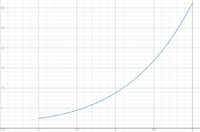Browns21284
New member
- Joined
- Feb 20, 2019
- Messages
- 1
The position of a particle moving along the y-axis at time t > 0 seconds is given by the function y(t)=2e^t-3t
a. Find the average velocity of the particle over the interval [1, 3]. Be sure to indicate correct units of measure.
b. In what direction is the particle moving and what is the particle’s velocity at t = 2 seconds? Justify your answers and be sure to indicate correct units of measure.
c. What is the acceleration of the particle when the velocity is zero? Show the analysis that leads to your answer and be sure to indicate correct units of measure.
d. Is the speed increasing or decreasing at t = 1.5 seconds? Justify your answer.
Thanks a lot for the help!
a. Find the average velocity of the particle over the interval [1, 3]. Be sure to indicate correct units of measure.
b. In what direction is the particle moving and what is the particle’s velocity at t = 2 seconds? Justify your answers and be sure to indicate correct units of measure.
c. What is the acceleration of the particle when the velocity is zero? Show the analysis that leads to your answer and be sure to indicate correct units of measure.
d. Is the speed increasing or decreasing at t = 1.5 seconds? Justify your answer.
Thanks a lot for the help!

